Abstract
The structural gene locus for apolipoprotein E (apo E) is polymorphic. Three common alleles (epsilon 2, epsilon 3, epsilon 4) code for three major isoforms in plasma and determine six apo E phenotypes that may be identified by isoelectric focusing on polyacrylamide. To establish what fraction of the inherited variation in a normal plasma lipid and lipoprotein profile is attributable to the segregation of the common alleles at the apo E gene locus, we have estimated the average apo E allelic effects on plasma cholesterol (C), triglycerides, very low-density lipoprotein (VLDL)-C, VLDL-apo B, low-density lipoprotein (LDL)-C, LDL-apo B, and high-density lipoprotein (HDL)-C in a representative sample of normolipidemic individuals from Ottawa, Canada. Data from published studies were also analyzed by the same statistical procedures. As much as 16% of the genetic variance (8.3% of the total variance) for LDL-C could be accounted for by the apo E gene locus. After correction for differences in age, sex, height, and weight, it was found that the epsilon 2 allele lowered and the epsilon 4 allele raised total cholesterol, LDL-C, and LDL-apo B. No other gene has been identified that contributes as much to normal cholesterol variability. Analysis of these data and those of others also indicates that the apo E locus imparts a differential susceptibility to a variety of factors that promote hyperlipidemia. The hypothesis is proposed that the epsilon 2 allele protects against coronary heart disease (CHD) and, hence, gives a reproductive advantage that is balanced by a predisposition to CHD when the epsilon 2 is combined with a second, independent causative factor to give a reproductive disadvantage. A similar mechanism is proposed for the maintenance of the epsilon 4 allele in the population.
Full text
PDF

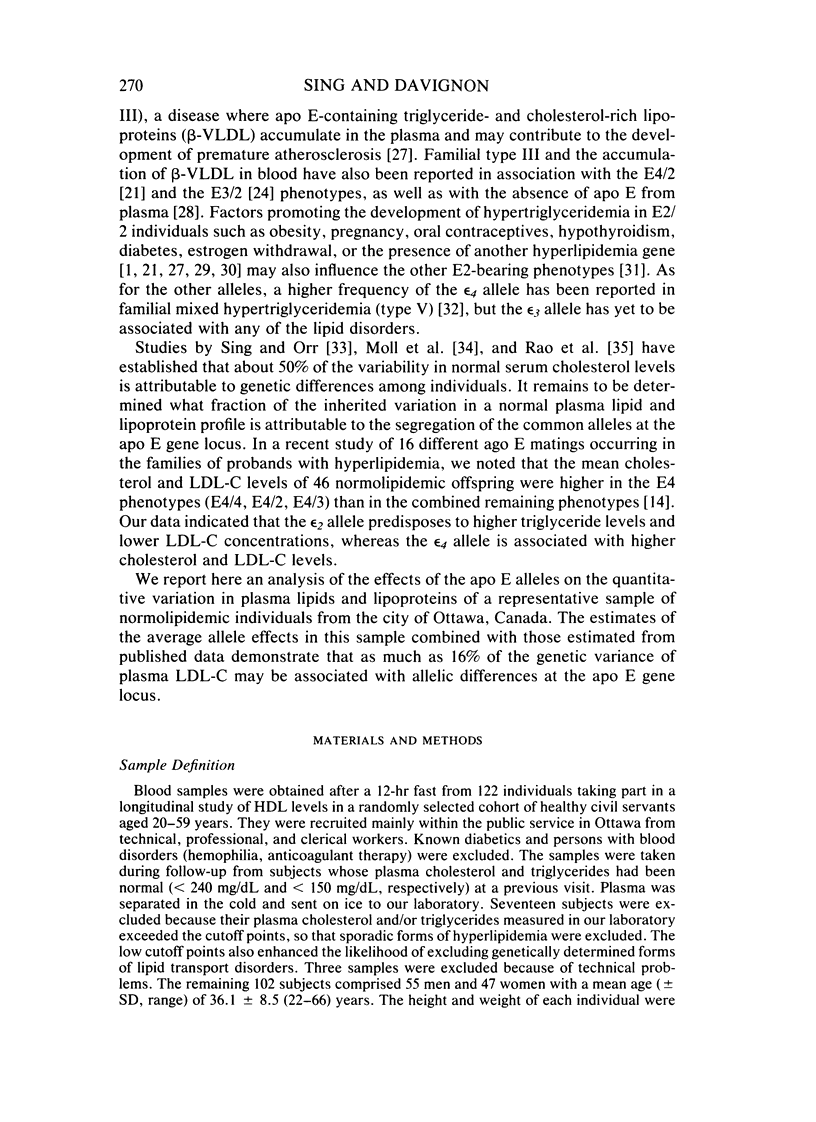
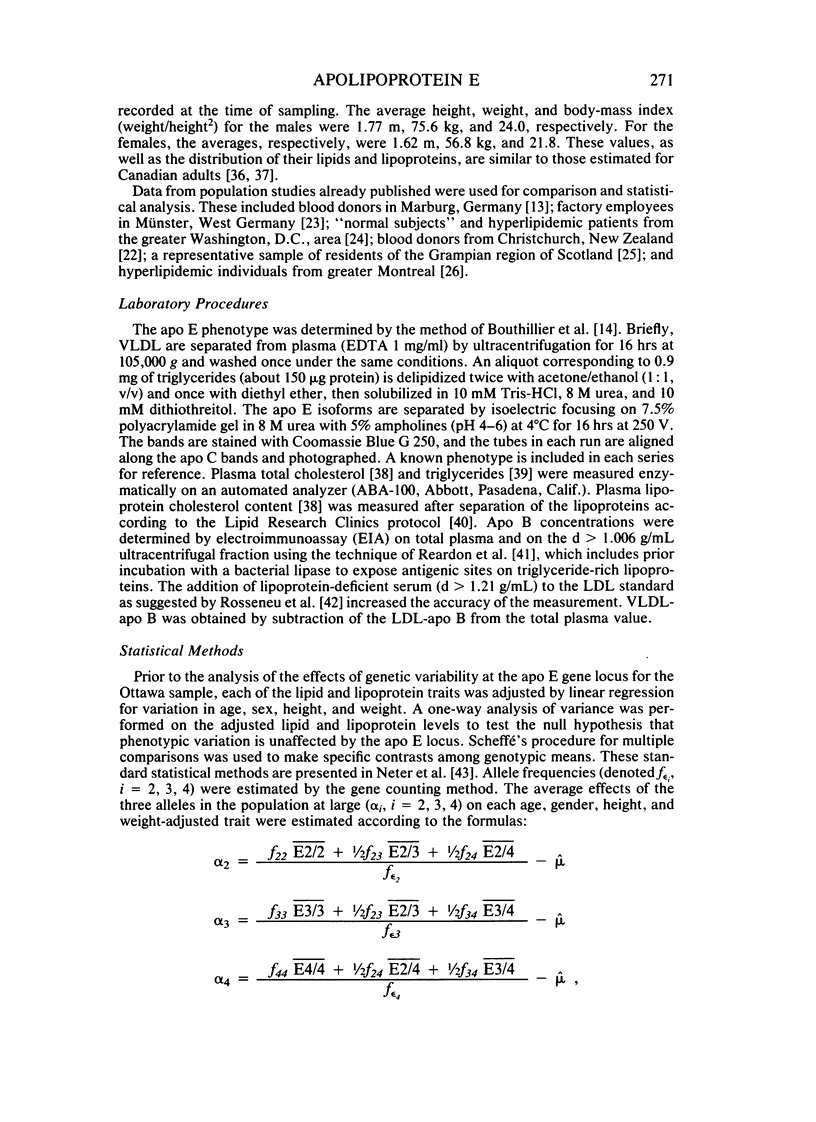
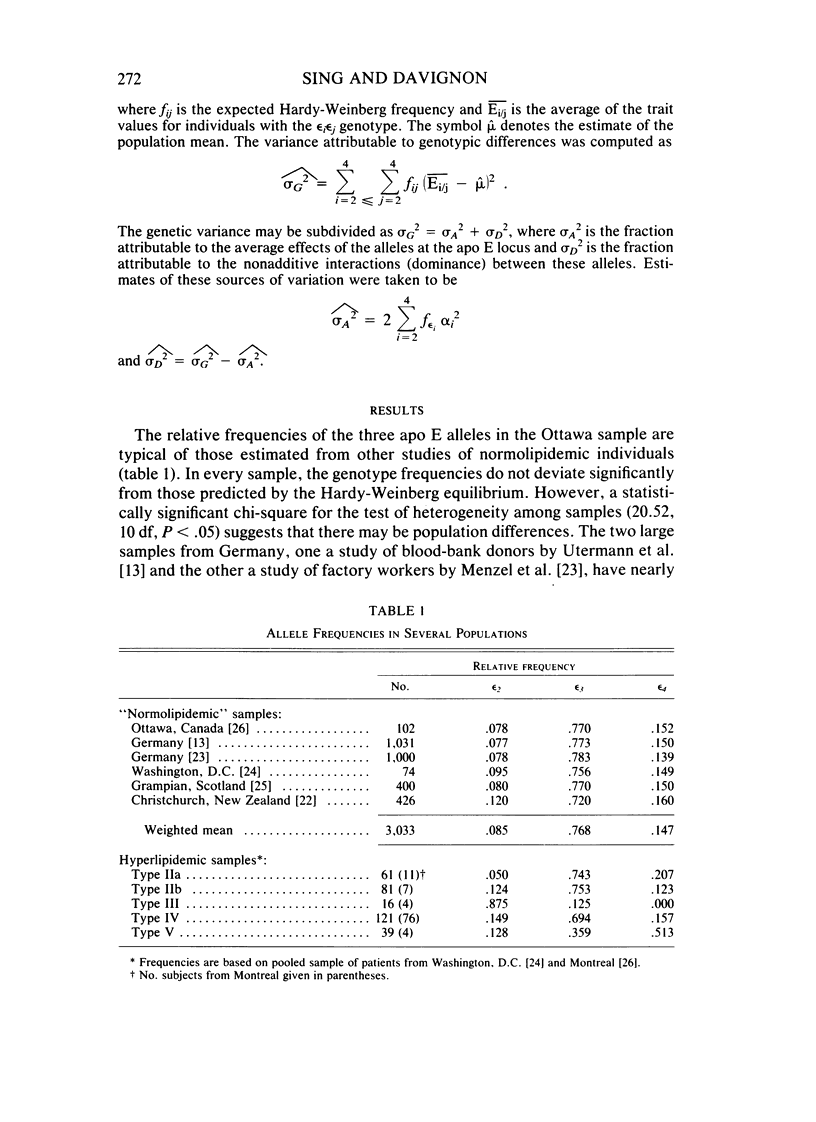
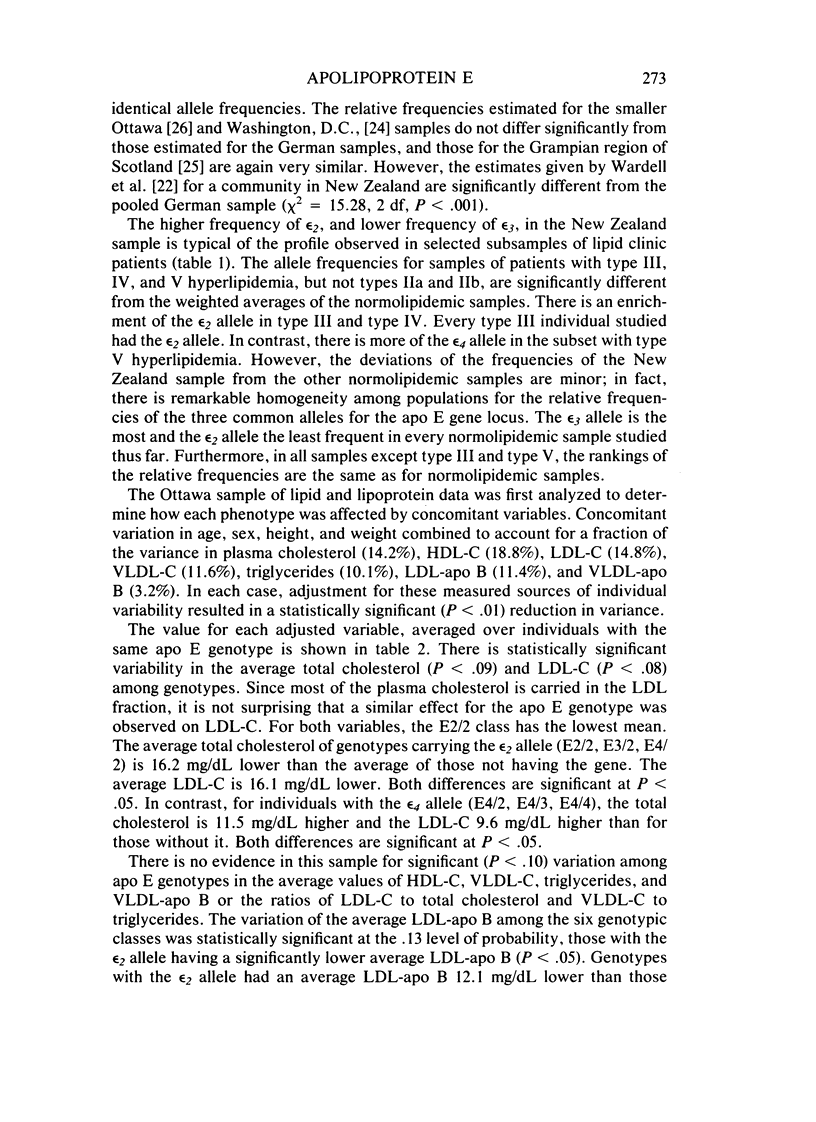


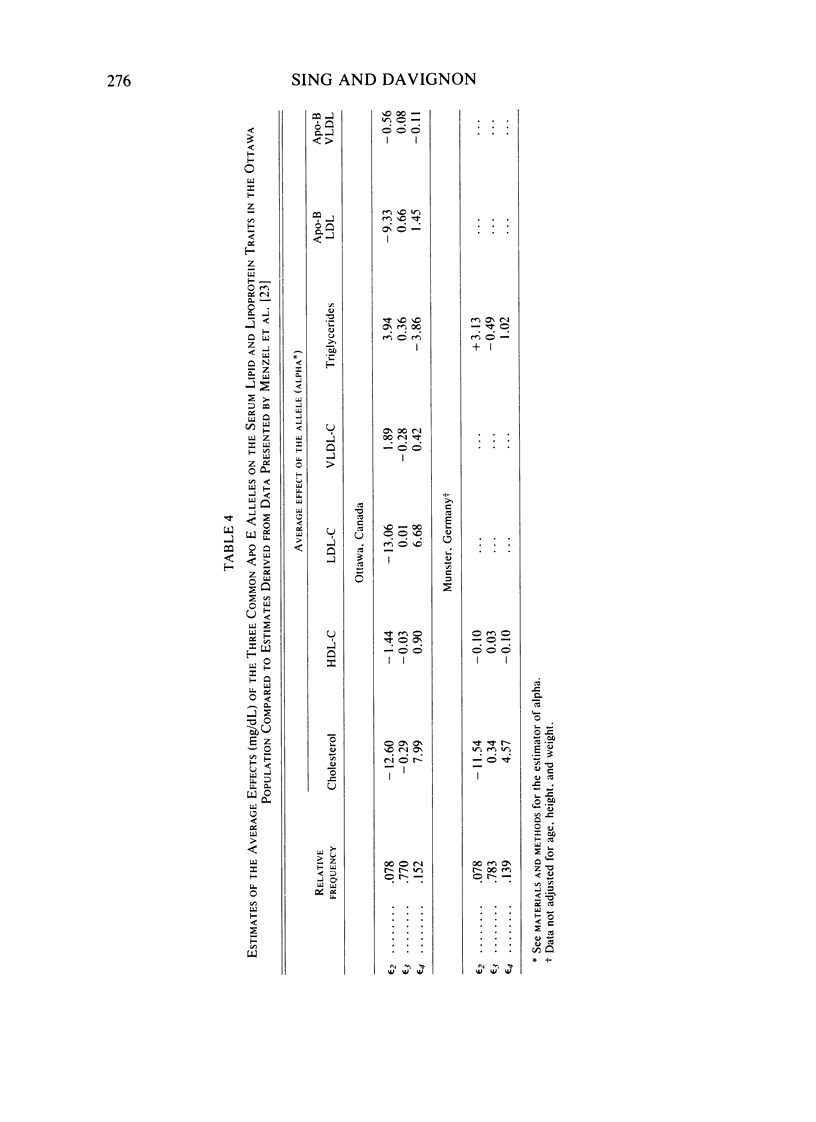


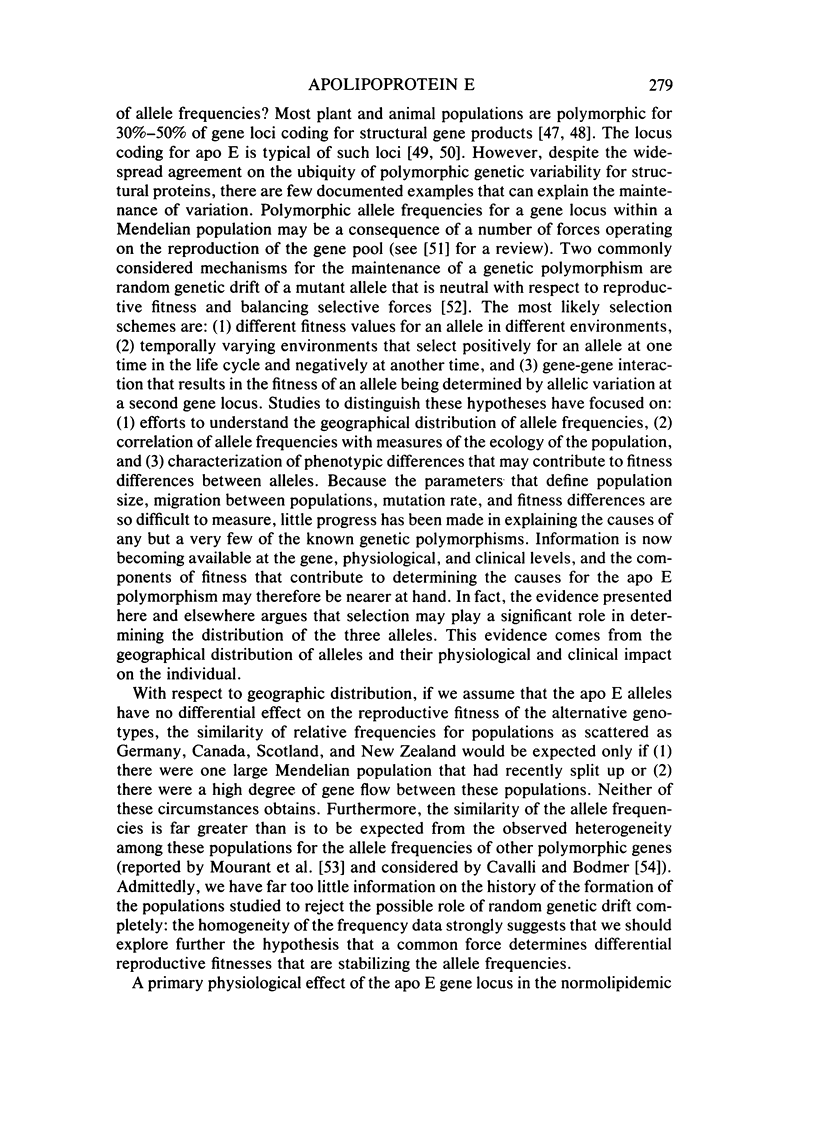
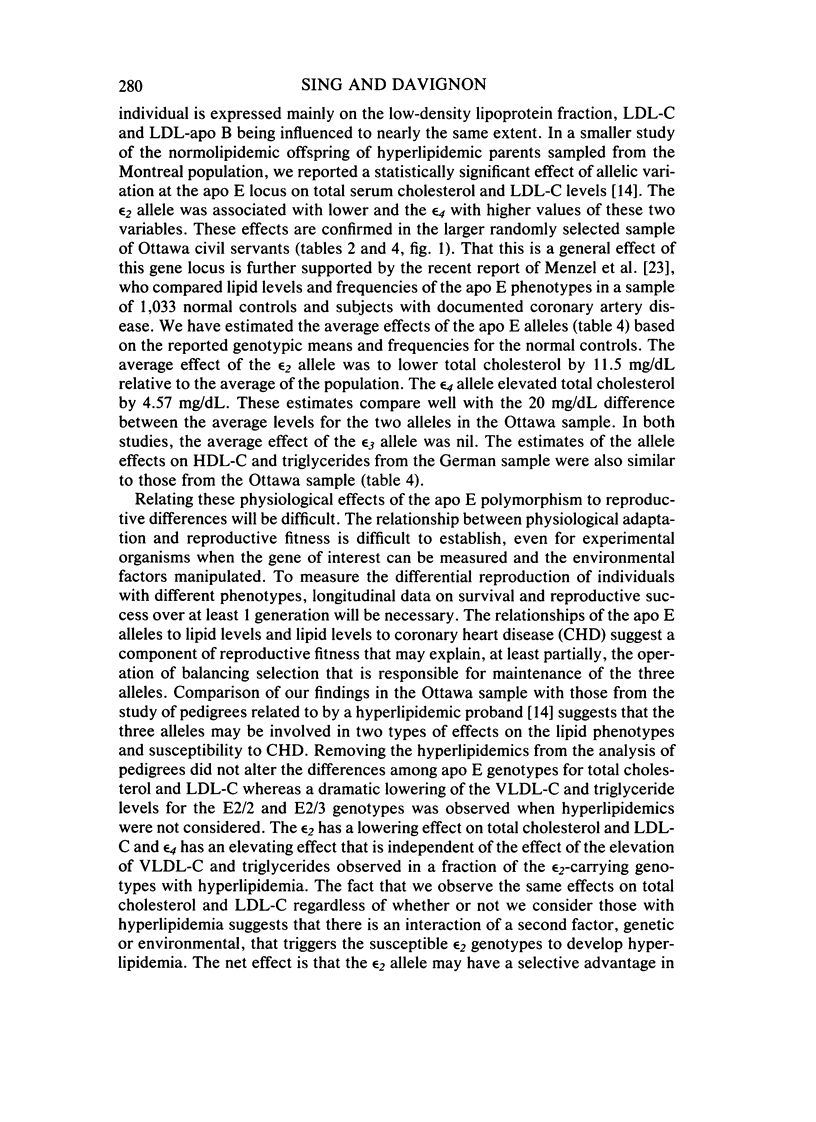





Selected References
These references are in PubMed. This may not be the complete list of references from this article.
- Allain C. C., Poon L. S., Chan C. S., Richmond W., Fu P. C. Enzymatic determination of total serum cholesterol. Clin Chem. 1974 Apr;20(4):470–475. [PubMed] [Google Scholar]
- Basu S. K., Goldstein J. L., Brown M. S. Independent pathways for secretion of cholesterol and apolipoprotein E by macrophages. Science. 1983 Feb 18;219(4586):871–873. doi: 10.1126/science.6823554. [DOI] [PubMed] [Google Scholar]
- Basu S. K., Ho Y. K., Brown M. S., Bilheimer D. W., Anderson R. G., Goldstein J. L. Biochemical and genetic studies of the apoprotein E secreted by mouse macrophages and human monocytes. J Biol Chem. 1982 Aug 25;257(16):9788–9795. [PubMed] [Google Scholar]
- Blue M. L., Williams D. L., Zucker S., Khan S. A., Blum C. B. Apolipoprotein E synthesis in human kidney, adrenal gland, and liver. Proc Natl Acad Sci U S A. 1983 Jan;80(1):283–287. doi: 10.1073/pnas.80.1.283. [DOI] [PMC free article] [PubMed] [Google Scholar]
- Bouthillier D., Sing C. F., Davignon J. Apolipoprotein E phenotyping with a single gel method: application to the study of informative matings. J Lipid Res. 1983 Aug;24(8):1060–1069. [PubMed] [Google Scholar]
- Breslow J. L., Zannis V. I., SanGiacomo T. R., Third J. L., Tracy T., Glueck C. J. Studies of familial type III hyperlipoproteinemia using as a genetic marker the apoE phenotype E2/2. J Lipid Res. 1982 Nov;23(8):1224–1235. [PubMed] [Google Scholar]
- Connor S. L., Connor W. E., Sexton G., Calvin L., Bacon S. The effects of age, body wight and family relationships on plasma lipoproteins and lipids in men, women and children of randomly selected families. Circulation. 1982 Jun;65(7):1290–1298. doi: 10.1161/01.cir.65.7.1290. [DOI] [PubMed] [Google Scholar]
- Cumming A. M., Robertson F. W. Polymorphism at the apoprotein-E locus in relation to risk of coronary disease. Clin Genet. 1984 Apr;25(4):310–313. doi: 10.1111/j.1399-0004.1984.tb01995.x. [DOI] [PubMed] [Google Scholar]
- Davignon J., Bouthillier D., Dufour R., Lussier-Cacan S. Xanthomes et athérosclérose en présence de lipides plasmatiques normaux. Ann Med Interne (Paris) 1983;134(5):483–491. [PubMed] [Google Scholar]
- Ghiselli G., Gregg R. E., Zech L. A., Schaefer E. J., Brewer H. B., Jr Phenotype study of apolipoprotein E isoforms in hyperlipoproteinaemic patients. Lancet. 1982 Aug 21;2(8295):405–407. doi: 10.1016/s0140-6736(82)90439-1. [DOI] [PubMed] [Google Scholar]
- Ghiselli G., Schaefer E. J., Gascon P., Breser H. B., Jr Type III hyperlipoproteinemia associated with apolipoprotein E deficiency. Science. 1981 Dec 11;214(4526):1239–1241. doi: 10.1126/science.6795720. [DOI] [PubMed] [Google Scholar]
- Ghiselli G., Schaefer E. J., Zech L. A., Gregg R. E., Brewer H. B., Jr Increased prevalence of apolipoprotein E4 in type V hyperlipoproteinemia. J Clin Invest. 1982 Aug;70(2):474–477. doi: 10.1172/JCI110638. [DOI] [PMC free article] [PubMed] [Google Scholar]
- Gregg R. E., Ghiselli G., Brewer H. B., Jr Apolipoprotein EBethesda: a new variant of apolipoprotein E associated with type III hyperlipoproteinemia. J Clin Endocrinol Metab. 1983 Nov;57(5):969–974. doi: 10.1210/jcem-57-5-969. [DOI] [PubMed] [Google Scholar]
- Havel R. J., Chao Y., Windler E. E., Kotite L., Guo L. S. Isoprotein specificity in the hepatic uptake of apolipoprotein E and the pathogenesis of familial dysbetalipoproteinemia. Proc Natl Acad Sci U S A. 1980 Jul;77(7):4349–4353. doi: 10.1073/pnas.77.7.4349. [DOI] [PMC free article] [PubMed] [Google Scholar]
- Havel R. J. Familial dysbetalipoproteinemia. New aspects of pathogenesis and diagnosis. Med Clin North Am. 1982 Mar;66(2):441–454. doi: 10.1016/s0025-7125(16)31429-8. [DOI] [PubMed] [Google Scholar]
- Hazzard W. R., Warnick G. R., Utermann G., Albers J. J. Genetic transmission of isoapolipoprotein E phenotypes in a large kindred: relationship to dysbetalipoproteinemia and hyperlipidemia. Metabolism. 1981 Jan;30(1):79–88. doi: 10.1016/0026-0495(81)90223-7. [DOI] [PubMed] [Google Scholar]
- Hewitt D., Jones G. J., Godin G. J., McComb K., Breckenridge W. C., Little J. A., Steiner G., Mishkel M. A., Baillie J. H., Martin R. H. Normative standards of plasma cholesterol and triglyceride concentrations in Canadians of working age. Can Med Assoc J. 1977 Nov 5;117(9):1020–1024. [PMC free article] [PubMed] [Google Scholar]
- Innerarity T. L., Mahley R. W. Enhanced binding by cultured human fibroblasts of apo-E-containing lipoproteins as compared with low density lipoproteins. Biochemistry. 1978 Apr 18;17(8):1440–1447. doi: 10.1021/bi00601a013. [DOI] [PubMed] [Google Scholar]
- Jain R. S., Quarfordt S. H. The carbohydrate content of apolipoprotein E from human very low density lipoproteins. Life Sci. 1979 Oct 8;25(15):1315–1323. doi: 10.1016/0024-3205(79)90397-7. [DOI] [PubMed] [Google Scholar]
- Jones G. J., Hewitt D., Godin G. J., Breckenridge W. C., Bird J., Mishkel M. A., Steiner G., Little J. A. Plasma lipoprotein levels and the prevalence of hyperlipoproteinemia in a Canadian working population. Can Med Assoc J. 1980 Jan 12;122(1):37-8, 40-6. [PMC free article] [PubMed] [Google Scholar]
- Kannel W. B., Castelli W. P., Gordon T. Cholesterol in the prediction of atherosclerotic disease. New perspectives based on the Framingham study. Ann Intern Med. 1979 Jan;90(1):85–91. doi: 10.7326/0003-4819-90-1-85. [DOI] [PubMed] [Google Scholar]
- Mahley R. W. Atherogenic hyperlipoproteinemia. The cellular and molecular biology of plasma lipoproteins altered by dietary fat and cholesterol. Med Clin North Am. 1982 Mar;66(2):375–402. doi: 10.1016/s0025-7125(16)31426-2. [DOI] [PubMed] [Google Scholar]
- Mahley R. W., Hui D. Y., Innerarity T. L., Weisgraber K. H. Two independent lipoprotein receptors on hepatic membranes of dog, swine, and man. Apo-B,E and apo-E receptors. J Clin Invest. 1981 Nov;68(5):1197–1206. doi: 10.1172/JCI110365. [DOI] [PMC free article] [PubMed] [Google Scholar]
- Mahley R. W., Innerarity T. L. Lipoprotein receptors and cholesterol homeostasis. Biochim Biophys Acta. 1983 May 24;737(2):197–222. doi: 10.1016/0304-4157(83)90001-1. [DOI] [PubMed] [Google Scholar]
- Menzel H. J., Kladetzky R. G., Assmann G. Apolipoprotein E polymorphism and coronary artery disease. Arteriosclerosis. 1983 Jul-Aug;3(4):310–315. doi: 10.1161/01.atv.3.4.310. [DOI] [PubMed] [Google Scholar]
- Moll P. P., Powsner R., Sing C. F. Analysis of genetic and environmental sources of variation in serum cholesterol in Tecumseh, Michigan. V. Variance components estimated from pedigrees. Ann Hum Genet. 1979 Jan;42(3):343–354. doi: 10.1111/j.1469-1809.1979.tb00668.x. [DOI] [PubMed] [Google Scholar]
- Muller D. P., Pavlou C., Whitelaw A. G., McLintock D. The effect of pregnancy and two different contraceptive pills on serum lipids and lipoproteins in a woman with a type III hyperlipoproteinaemia pattern. Br J Obstet Gynaecol. 1978 Feb;85(2):127–133. doi: 10.1111/j.1471-0528.1978.tb10466.x. [DOI] [PubMed] [Google Scholar]
- Nevo E. Genetic variation in natural populations: patterns and theory. Theor Popul Biol. 1978 Feb;13(1):121–177. doi: 10.1016/0040-5809(78)90039-4. [DOI] [PubMed] [Google Scholar]
- Rall S. C., Jr, Weisgraber K. H., Innerarity T. L., Mahley R. W. Identical structural and receptor binding defects in apolipoprotein E2 in hypo-, normo-, and hypercholesterolemic dysbetalipoproteinemia. J Clin Invest. 1983 Apr;71(4):1023–1031. doi: 10.1172/JCI110829. [DOI] [PMC free article] [PubMed] [Google Scholar]
- Rall S. C., Jr, Weisgraber K. H., Innerarity T. L., Mahley R. W. Structural basis for receptor binding heterogeneity of apolipoprotein E from type III hyperlipoproteinemic subjects. Proc Natl Acad Sci U S A. 1982 Aug;79(15):4696–4700. doi: 10.1073/pnas.79.15.4696. [DOI] [PMC free article] [PubMed] [Google Scholar]
- Rao D. C., Morton N. E., Gulbrandsen C. L., Rhoads G. G., Kagan A., Yee S. Cultural and biological determinants of lipoprotein concentrations. Ann Hum Genet. 1979 May;42(4):467–477. doi: 10.1111/j.1469-1809.1979.tb00680.x. [DOI] [PubMed] [Google Scholar]
- Reardon M. F., Poapst M. E., Uffelman K. D., Steiner G. Improved method for quantitation of B apoprotein in plasma lipoproteins by electroimmunoassay. Clin Chem. 1981 Jun;27(6):892–895. [PubMed] [Google Scholar]
- Roheim P. S., Carey M., Forte T., Vega G. L. Apolipoproteins in human cerebrospinal fluid. Proc Natl Acad Sci U S A. 1979 Sep;76(9):4646–4649. doi: 10.1073/pnas.76.9.4646. [DOI] [PMC free article] [PubMed] [Google Scholar]
- Rosenblum B. B., Neel J. V., Hanash S. M. Two-dimensional electrophoresis of plasma polypeptides reveals "high" heterozygosity indices. Proc Natl Acad Sci U S A. 1983 Aug;80(16):5002–5006. doi: 10.1073/pnas.80.16.5002. [DOI] [PMC free article] [PubMed] [Google Scholar]
- Rosseneu M., Vinaimont N., Vercaemst R., Dekeersgieter W., Belpaire F. Standardization of immunoassays for the quantitation of plasma Apo B protein. Anal Biochem. 1981 Sep 1;116(1):204–210. doi: 10.1016/0003-2697(81)90345-6. [DOI] [PubMed] [Google Scholar]
- Sampson E. J., Demers L. M., Krieg A. F. Faster enzymatic procedure for serum triglycerides. Clin Chem. 1975 Dec;21(13):1983–1985. [PubMed] [Google Scholar]
- Schneider W. J., Kovanen P. T., Brown M. S., Goldstein J. L., Utermann G., Weber W., Havel R. J., Kotite L., Kane J. P., Innerarity T. L. Familial dysbetalipoproteinemia. Abnormal binding of mutant apoprotein E to low density lipoprotein receptors of human fibroblasts and membranes from liver and adrenal of rats, rabbits, and cows. J Clin Invest. 1981 Oct;68(4):1075–1085. doi: 10.1172/JCI110330. [DOI] [PMC free article] [PubMed] [Google Scholar]
- Sing C. F., Chamberlain M. A., Block W. D., Feiler S. Analysis of genetic and environmental sources of variation in serum cholesterol in Tecumseh, Michigan. I. Analysis of the frequency distribution for evidence of a genetic polymorphism. Am J Hum Genet. 1975 May;27(3):333–347. [PMC free article] [PubMed] [Google Scholar]
- Sing C. F., Orr J. D. Analysis of genetic and environmental sources of variation in serum cholesterol in Tecumseh, Michigan. III. Identification of genetic effects using 12 polymorphic genetic blood marker systems. Am J Hum Genet. 1976 Sep;28(5):453–464. [PMC free article] [PubMed] [Google Scholar]
- Sing C. F., Orr J. D. Analysis of genetic and environmental sources of variation in serum cholesterol in Tecumseh, Michigan. IV. Separation of polygene from common environment effects. Am J Hum Genet. 1978 Sep;30(5):491–504. [PMC free article] [PubMed] [Google Scholar]
- Utermann G., Hees M., Steinmetz A. Polymorphism of apolipoprotein E and occurrence of dysbetalipoproteinaemia in man. Nature. 1977 Oct 13;269(5629):604–607. doi: 10.1038/269604a0. [DOI] [PubMed] [Google Scholar]
- Utermann G., Pruin N., Steinmetz A. Polymorphism of apolipoprotein E. III. Effect of a single polymorphic gene locus on plasma lipid levels in man. Clin Genet. 1979 Jan;15(1):63–72. [PubMed] [Google Scholar]
- Utermann G., Steinmetz A., Weber W. Genetic control of human apolipoprotein E polymorphism: comparison of one- and two-dimensional techniques of isoprotein analysis. Hum Genet. 1982;60(4):344–351. doi: 10.1007/BF00569216. [DOI] [PubMed] [Google Scholar]
- Wardell M. R., Suckling P. A., Janus E. D. Genetic variation in human apolipoprotein E. J Lipid Res. 1982 Nov;23(8):1174–1182. [PubMed] [Google Scholar]
- Weisgraber K. H., Rall S. C., Jr, Mahley R. W. Human E apoprotein heterogeneity. Cysteine-arginine interchanges in the amino acid sequence of the apo-E isoforms. J Biol Chem. 1981 Sep 10;256(17):9077–9083. [PubMed] [Google Scholar]
- Zannis V. I., Breslow J. L. Human very low density lipoprotein apolipoprotein E isoprotein polymorphism is explained by genetic variation and posttranslational modification. Biochemistry. 1981 Feb 17;20(4):1033–1041. doi: 10.1021/bi00507a059. [DOI] [PubMed] [Google Scholar]
- Zannis V. I., Breslow J. L., Utermann G., Mahley R. W., Weisgraber K. H., Havel R. J., Goldstein J. L., Brown M. S., Schonfeld G., Hazzard W. R. Proposed nomenclature of apoE isoproteins, apoE genotypes, and phenotypes. J Lipid Res. 1982 Aug;23(6):911–914. [PubMed] [Google Scholar]


